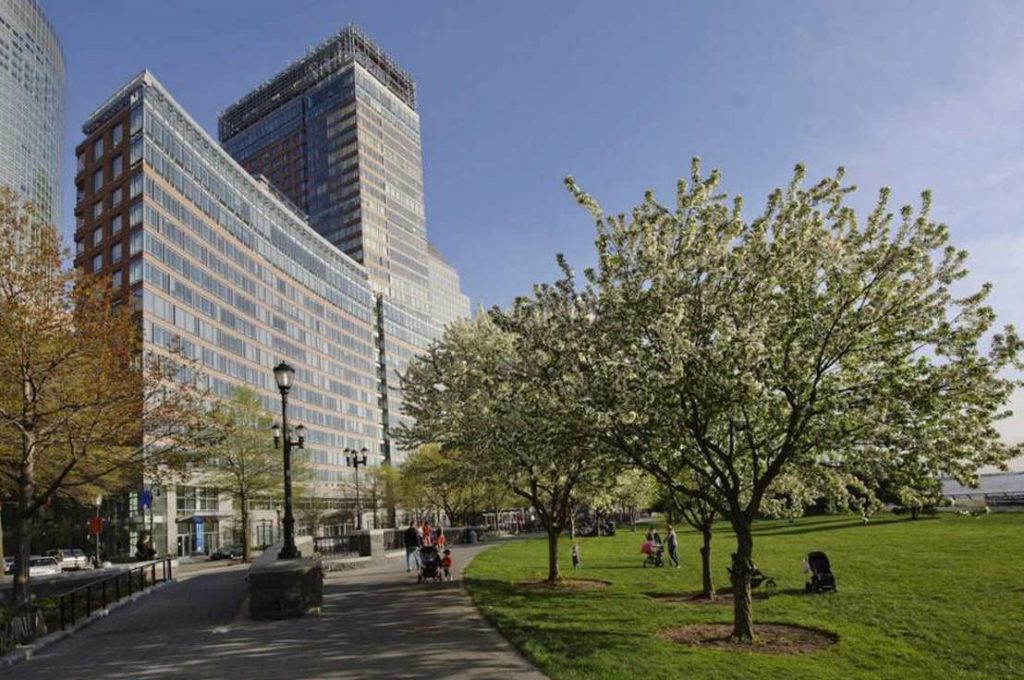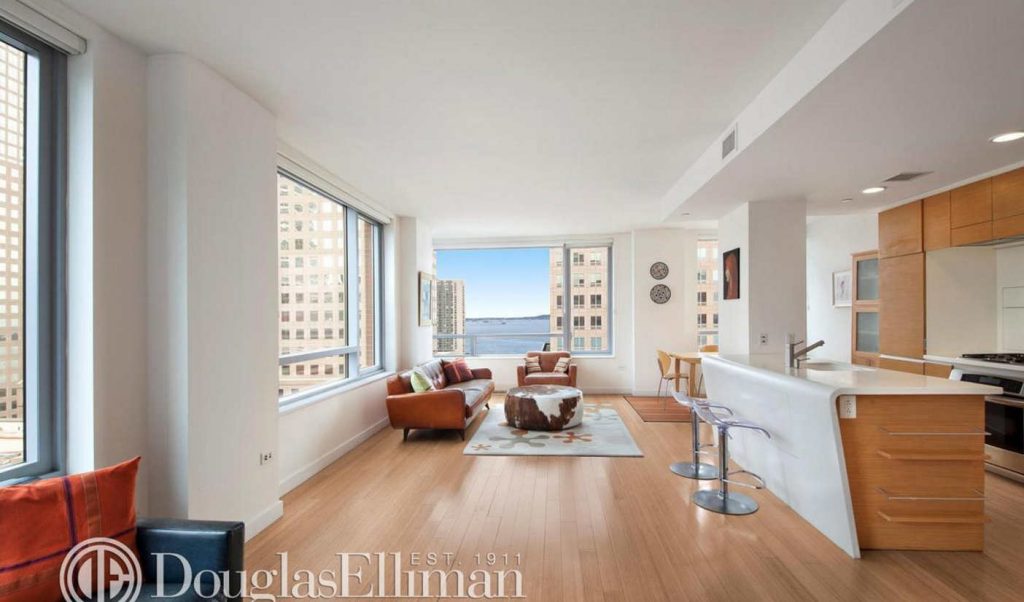Can the city that never sleeps also be a city that grows green? We’re not talking green like Wall Street traders trying to stockpile cash money, we’re talking green as in green buildings.
In 2005, New York City adopted one of the nation’s first green building laws, which requires new buildings and reconstruction projects that receive city funds to meet LEED standards. New York City’s most defining feature is its density of buildings, which is also its most intense source of pollution, so it makes sense that the effort to clean up the air starts there.
On Earth Day 2016, we thought it worthwhile to take the pulse of sustainability experts and real estate professionals on the issue of where New York City stands in its move towards green technologies. Local Law 84 requires NYC buildings to report energy use to the city, so NYC residents can see how well their buildings are doing and, more important, how committed landlords are to investing in their buildings.
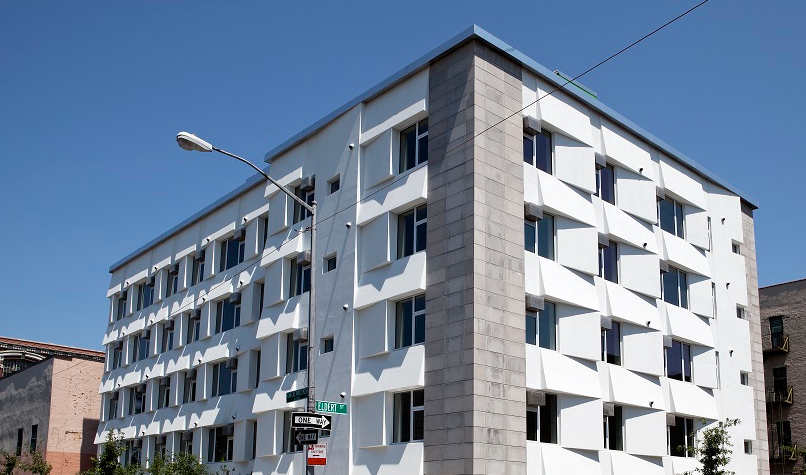
Passive house at 803 Knickerbocker Ave. in Bushwick. (Source: EIMA)
What we found was that sustainability comes in several shapes and sizes — from Energy Star ratings that demonstrate efficiency to LEED certification for exemplary green amenities to “passive house” design that lowers energy costs by 80 percent.
What we also found is that New York City’s aim to reduce its carbon footprint has produced strong, new codes that make building owners and landlords accountable for energy use. The commercial real estate developers led the way, since industry standards for those types of buildings made LEED certification standard practice. Now, the residential market is catching up — and it has become the right thing for buyers and renters to include sustainability on the list of issues to consider when apartment hunting.
What is a LEED Certification?
While many people have heard the term “LEED certification,” there’s less certainty about what it actually means. First of all, the acronym stands for Leadership in Energy and Environmental Design. To gain a level of LEED certification (Silver, Gold or Platinum), developers earn points based on the building’s energy use, water, materials, site issues and indoor qualities. Buildings can earn multiple certifications.
According to the New York State Energy Research and Development Authority (NYSERDA), an agency that promotes energy efficiency and the use of renewable energy sources, New York City residents may want to consider seeking LEED-certified buildings — and ask how a building they’re considering renting or buying gained its LEED certification.
Laura Humphrey, a senior project manager at NYSERDA said:
LEED-certified buildings can confirm “sustainable construction, non-toxic materials, air quality safeguard, more efficient heating and ventilation systems; LEED is intended to indicate that a building has less of an environmental impact than a comparable peer building and that it was built to a higher standard.’’
Humphrey added that “there are multiple categories in which buildings qualify so each building fits that mold (LEED-certification) in different ways.”
Number of LEED-Certified Buildings in NYC
The bulk of LEED-certified buildings in New York state are commercial, numbering more than 645 buildings, according to the U.S. Green Building Council. There were 12 LEED-certified residential buildings in New York City as of April 2016, including Riverhouse at 1 Rockefeller Park, but an additional 76 have registered to seek LEED certification.
At Riverhouse, the 32-story, LEED-Gold certified building is called the “greenest residential building on the East Coast.” It features twice-filtered air and water; low pollution-emitting paints, carpets and acoustical treatments and triple-glazed windows. But not all LEED buildings are exactly the same.
Solaire Breaks Into LEED Gold Standard
In 2003, The Solaire (below) was the first residential high-rise in the U.S. to receive a LEED Gold rating. The 27-story Battery Park City rental building contains 293 units featuring solar panels on the roof and a host of other green technologies, including an in-house water treatment center. These innovations help The Solaire use 50 percent less water and 30 percent less energy than other buildings of comparable size.
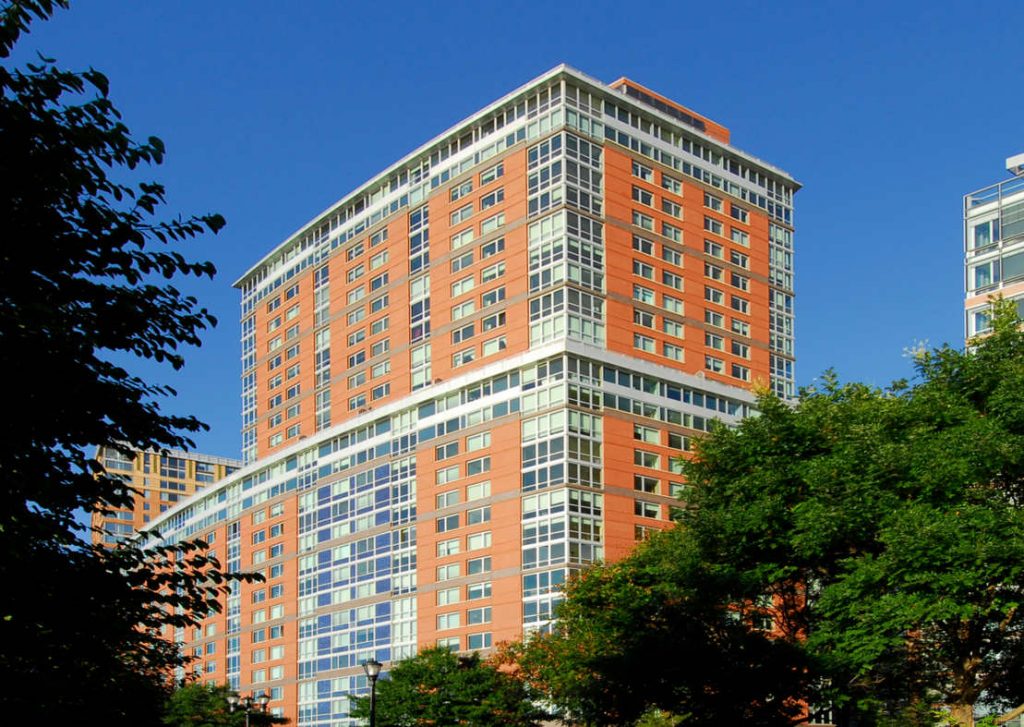
The Solaire at 20 River Terrace in BPC.
The Greenwich Lane (photo below), designed by FXFOWLE, is one of New York City’s noted LEED-Silver certified residential complexes. With 200 condominium units across seven buildings, The Greenwich Lane represents a pretty grand scale of sustainable development, which made it the first complex in the city to achieve a Gold Neighborhood Development Certification due to the use of triple-glazed windows, high-performance lights, water-efficient fixtures, and a cooling system and irrigation based on a storm water collection system.
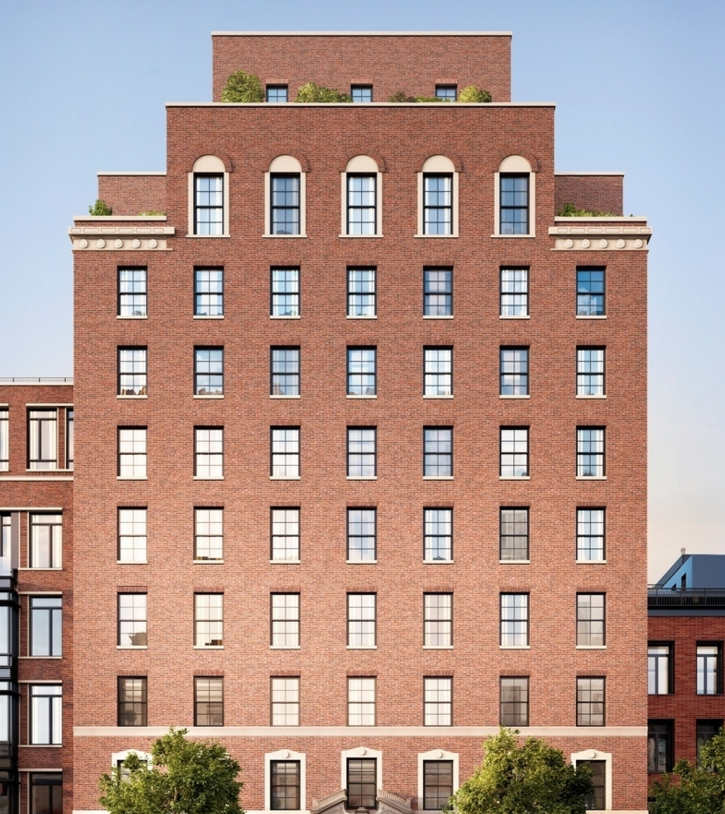
The Greenwich Lane.
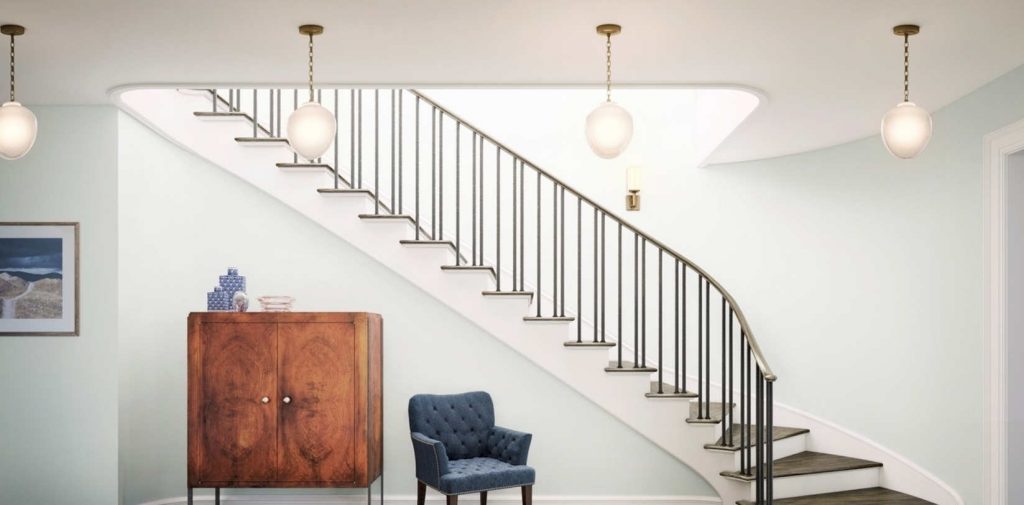
Style does not suffer as evidenced in this elegant stairway at The Greenwich Lane.
Ilana Judah, principal and director of sustainability at FXFOWLE, said NYC residents can ask to see the LEED checklist to see how a building achieved its LEED certification.
“What’s great about LEED is that it is addressing the whole building concerning waste and water usage. It means a healthy indoor environment, including low-emitting materials. Most people spend 90 percent of their time indoors, eight or nine in your apartment to sleep. There can be a lot of toxic stuff that people don’t know about from furniture and building materials,’’ Judah said.
In LEED-certified buildings, Judah said residents can see how developers turned to materials (built-in cabinets and furniture) that do not emit urea formaldehyde, which is a known carcinogen. With a premium on-air quality and air filtration systems, LEED-certified buildings can be checked to confirm that low-emitting paints, glues and adhesives were avoided.
What is an ENERGY STAR Certification?
While the LEED certification takes a more holistic approach and accounts for things like building materials and neighborhood development, the ENERGY STAR certification cuts right to energy performance. The ENERGY STAR rating system compares the energy use of a given building against similar buildings and assigns a score from 1-100. The closer to 100 a building gets, the better its energy performance relative to its peers.
The focus on energy performance implies a premium quality for other building attributes as well. A high-scoring building may have better indoor air quality and be more comfortable to live in. Higher energy performance means that the building will also have lower greenhouse gas emissions. The rating is associated with the year awarded however; renters and buyers would do well to investigate the age of the certification for their prospective building. With over 100 ENERGY STAR-rated projects in the city (and more on the way), there’s plenty of choice to live in an efficient home.
Passive House Design Can Cut Monthly Energy Costs up to 80 Percent
Another sustainable construction model that tops LEED certification are “passive house” buildings. This takes air quality, energy savings and sustainability to a whole new level, Judah said: “These are very energy efficient buildings that provide a very high level of fresh air, thermal comfort and acoustics and energy efficiency.’’
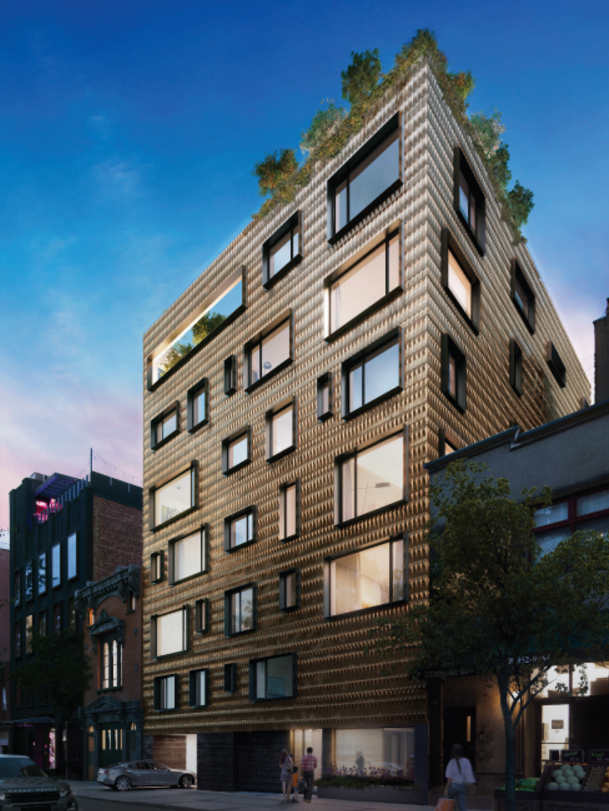
210 Pacific Street is a passive house design.
At 210 Pacific Street (above) in the Cobble Hill section of Brooklyn, an 8-unit condo building has made a brand-new example of the passive house approach to sustainability. Designed by Nava Companies, the 7-story building utilizes extensive insulation, individual energy recovery units and triple-glazed windows. A solar hot water system ensures energy independence as well as a positive environmental impact. Parking spaces provide EV (electric vehicle) charging stations.
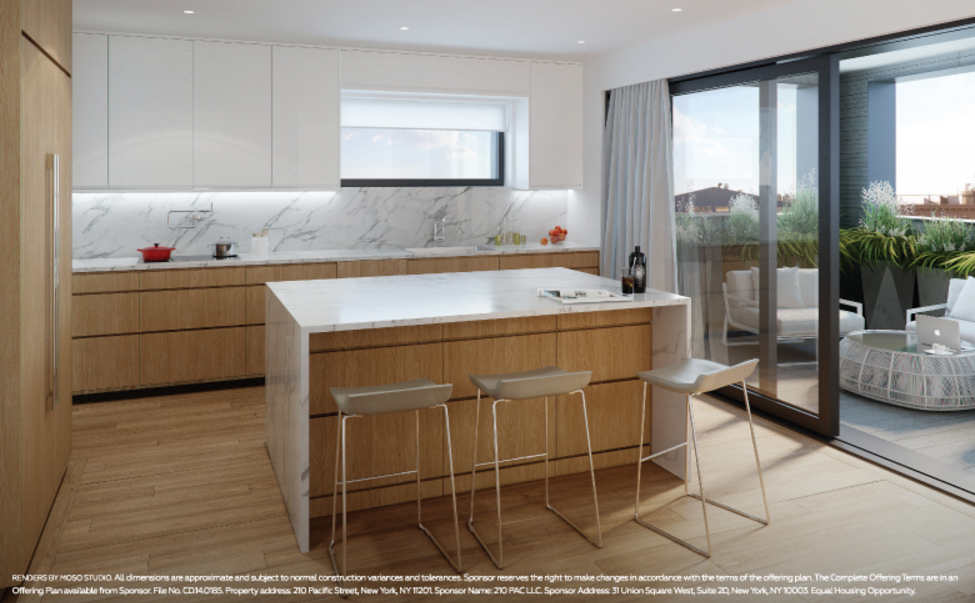
Kitchen for Unit #5 at 210 Pacific Street.
For all these cost-reducing and environmentally positive features, however, the primary drivers for buyer interest in 210 Pacific Street are design, price and location.
“We find New Yorkers are genuinely interested and concerned about the environment, but they’re far more concerned about price and location,’’ said Frans Preidel of Brown Harris Stevens, one of the co-brokers for 210 Pacific Street.
Buyers & Renters Aren’t Willing to Pay a Premium, But Appreciate Green Buildings
“I don’t think anybody came there because they were looking for environment like that, but once they understand, they appreciate it. That said, if there are two apartments next to each other offering the exact same things, it’s no sure thing that they’ll pick the passive house. That means these kinds of conscientiously design buildings have to compete on every other level with another building,’’ Preidel said.
However, time may prove a favorable condition for passive house construction like 210 Pacific Street, where there’s a reported 75-to-80 percent cut in energy costs. Central air systems are building-wide vs. individual systems for each of the eight units. Hot water is a collective system. There are fewer windows and smaller windows, which are triple-glazed for greater insulation.
“The big advantage will be on resale. That’s when there will be a history that proves the costs associated with a unit are lower than another property. It’s then you can say, ‘We have the tax abatement and the monthly cost for the passive house is, let’s say, $2,000 vs. $3,000,’’ Preidel said.
And while green building materials will cost more – think of a triple-glazed window vs. a double-glazed one — the costs are not severe and homeowners will enjoy a higher resale value. According to the U.S. Green Building Council, “…the upfront costs are 2.4% higher on average, and can be quickly recouped with the homeowners saving money for the rest of the home’s lifespan.”
Jeff Schleider, founder and CEO of Miron Properties and Miron Property Management, was a member of the LEED for Homes in NYC subcommittee several years ago. As a consultant to Manhattan and Brooklyn developers, Schleider said momentum for LEED and other sustainable residential building projects has slowed.
“The pullback of the green movement is fairly significant, except for buyers who for some specific reason need indoor air quality to be high due to asthma or some other condition. Many of our clients find it preferable, but it is not a top consideration,’’ Schleider said.
> See Green Apartments for Sale
> See Green Apartments for Rent
